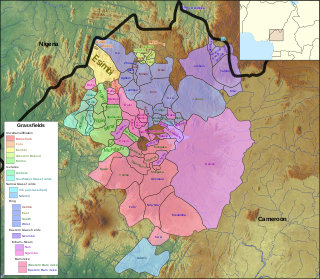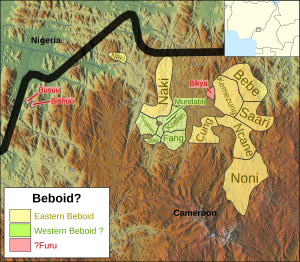
Niger–Congo is a hypothetical language family spoken over the majority of sub-Saharan Africa. It unites the Mande languages, the Atlantic-Congo languages, and possibly several smaller groups of languages that are difficult to classify. If valid, Niger-Congo would be the world's largest in terms of member languages, the third-largest in terms of speakers, and Africa's largest in terms of geographical area. It is generally considered to be the world's largest language family in terms of the number of distinct languages, just ahead of Austronesian, although this is complicated by the ambiguity about what constitutes a distinct language; the number of named Niger–Congo languages listed by Ethnologue is 1,540.
Bikya is a potentially extinct Southern Bantoid language spoken in Cameroon. It is one of the three, or four, Furu languages. In 1986 four surviving speakers were identified, although only one spoke the language fluently.
The Adamawa languages are a putative family of 80–90 languages scattered across the Adamawa Plateau in Central Africa, in northern Cameroon, north-western Central African Republic, southern Chad, and eastern Nigeria, spoken altogether by only one and a half million people. Joseph Greenberg classified them as one branch of the Adamawa–Ubangi family of Niger–Congo languages. They are among the least studied languages in Africa, and include many endangered languages; by far the largest is Mumuye, with 400,000 speakers. A couple of unclassified languages—notably Laal and Jalaa—are found along the fringes of the Adamawa area.
Mbum Proper is a Adamawa–Ubangi language of Central Africa. It is spoken by about 50,000 people in Cameroon and the Central African Republic.

Southern Bantoid is a branch of the Bantoid language family. It consists of the Bantu languages along with several small branches and isolates of eastern Nigeria and west-central Cameroon. Since the Bantu languages are spoken across most of Sub-Saharan Africa, Southern Bantoid comprises 643 languages as counted by Ethnologue, though many of these are mutually intelligible.
The Mbum or Kebi-Benue languages are a group of the Mbum–Day branch of the Adamawa languages, spoken in southern Chad, northwestern Central African Republic, northern Cameroon and eastern Nigeria. Their best-known member is Mbum; other languages in the group include Tupuri and Kare.

The Tivoid languages are a branch of the Southern Bantoid languages spoken in parts of Nigeria and Cameroon. The subfamily takes its name after Tiv, the most spoken language in the group.

There are over 525 native languages spoken in Nigeria. The official language and most widely spoken lingua franca is English, which was the language of Colonial Nigeria. Nigerian Pidgin – an English-based creole – is spoken by 30 million people in Nigeria.
The Savannas languages, also known as Gur–Adamawa or Adamawa–Gur, is a branch of the Niger–Congo languages that includes Greenberg's Gur and Adamawa–Ubangui families.

The Grassfields languages are a branch of the Southern Bantoid languages spoken in the Western High Plateau of Cameroon and some parts of Taraba state, Nigeria. Better known Grassfields languages include the Eastern Grassfields languages, Bamun, Yamba, Bali, and Bafut and the Ring languages, Kom, Nso, and Oku. Almost all of these languages are closely related, sharing approximately half of their vocabulary.
Kemezung is a Southern Bantoid language of Cameroon. According to Ethnologue, it's 85% lexically similar to Bebe.
Ukaan is a poorly described Niger–Congo language or dialect cluster of uncertain affiliation. Roger Blench suspects, based on wordlists, that it might be closest to the (East) Benue–Congo languages. Blench (2012) states that "noun-classes and concord make it look Benue-Congo, but evidence is weak."

Misaje is a town and commune in Donga-Mantung department in the Northwest Region of Cameroon. The town lies at the top of the Ring Road, about 15 kilometers west of Nkambé, where the Ring Road meets the road north to Dumbu and the border with Nigeria.
The Furu languages are a proposed group of poorly attested extinct or nearly extinct and otherwise unclassified Southern Bantoid languages of Cameroon. Suggested Furu languages are:
Limbum is a Grassfields language of Cameroon, with a small number of speakers in Nigeria. It is used as a trade language by some, but is primarily the mother tongue of the Wimbum people, who live in Donga-Mantung division of the Northwest Region, at the top of the Ring Road.
Fang is a Southern Bantoid language of Cameroon.
Koshin is a Southern Bantoid language of Cameroon. It is traditionally classified as a Western Beboid language, but that has not been demonstrated to be a valid family.
Mundabli is a Southern Bantoid language of Cameroon. It is traditionally classified as a Western Beboid language, but that has not been demonstrated to be a valid family.
Mbuʼ, or Ajumbu, is a Southern Bantoid language of Cameroon. It is traditionally classified as a Western Beboid language, but that has not been demonstrated to be a valid family. Inasmuch as Western Beboid may be valid, Mbuʼ would appear to be the most divergent of its languages.
Bebe, or Naami, is an Eastern Beboid language of Cameroon. According to Ethnologue, it's 85% lexically similar to Kemezung.






